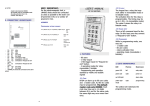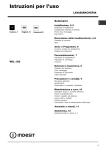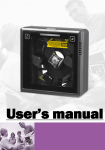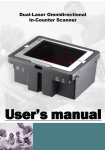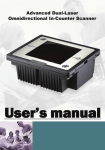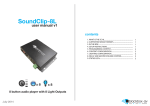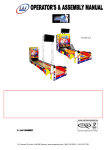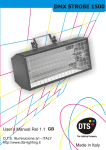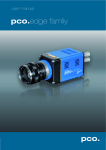Download USER'S MANUAL
Transcript
- JUMPERS Pin Pin Pin Pin Pin Pin Pin Pin Pin Pin Pin Pin Pin Pin Pin Pin Pin TAMPER the keypad works in monostable mode the outputs activation time is 5s. input 1 is associated to output 1. input 2 is associated to output 2. inputs are Normally Closed POWER LED stays lit. SIGNIFICANCE JP1 Opened: The transistor outputs are opencollector . Closed: The transistor outputs are at 12 V. This case, the current delivered on each output cannot exceed 200-250mA. JP2 Used to set the outputs either as relay outputs or as open-collecor. JP2 consists of 4 Jumpers of 2 pins each, numbered on the board as 4 3 2 1: JP2-x (x=1, 2, 3, 4) Opened: x output - open-collector Closed: x output - relay C2 NC2 NO1 C1 NC1 T4 T3 T2 T1 N1 N2 GND 12V +Z1 -Z1 +Z2 -Z2 pins relay 2 relay 2 relay 1 relay 1 relay 1 transistor 4 output transistor 3 output transistor 2 output transistor 1 output (not used) (not used) connected to GND connected to +12V DC command input 1 GND command input 2 GND to be connected to the alarm system USERS MANUAL the output is in bistable mode. 1.3 COMMAND INPUTS This are two NO/NC programmable command inputs. For both, the activation time and the associated outpus may be programmed. KP 2 KEYPAD 1.4 PROGRAMMING While in programming mode, one may set: - 1 master code - 60 user codes - codes corresponding outputs - outputs activation times - operating mode (monostable / bistable) - command inputs 2. DEFAULT PARAMETERS Master code 000000. Outputs activation time 5 s. Input 1 is associated to output 1. Input 2 is associated to output 4. Inputs are set as NC. APENDIX JP3 Used for set up to default (See set-up to default procedure). PROGRAMMING OPTIONS SUMMARY **** (MASTER # 1 # (ADDRESS) # (NEW CODE) CODE) # MODIFY/ ADD CODE 9. CONNECTORS SIGNIFICANCE **** (MASTER CODE) # 2 # (ADDRESS) # ERASE **** (MASTER CODE) # 3 # (OUTPUT NO.) # (TIME)# PROGRAMMING OUTPUTS USER CODE ACTIVATING TIME **** (MASTER CODE) # 4 # (INPUT NO.) # (TIME)# (ENTRY TYPE) # (ACIVATED OUTPUTS) # PROGRAMMING INPUTS **** (MASTER CODE) #0# RESET CODES USERS 3. LEDS SIGNIFICANCE 1. FEATURES - 60 users - 4 independent outputs, hardware setting as open collector or relay outputs, software setting for trigger time. - 2 programmable trigger inputs; - 2 operating modes for outputs: monostable/ bistable - Programming and operation assisted by visible and audible signals NO4 C4 NC4 NO3 C3 NC3 NO2 relay relay relay relay relay relay relay -4- red LED yellow LED right right SIGNIFICANCE outputs state keypad powered ON alarm state programming mode 4. AUDIBLE SIGNALS SIGNIFICANCE 1.2 OUTPUTS The keypad has 4 outputs which may be set either as relay or as open-collector outputs. They may work either in monostable mode or in bistable mode. The activation time for each output is programmable. The timing may be up to 1-99 s. (in monostable mode). The value 0 means 4 4 4 3 3 3 2 POSITION left right The yellow LED witnesses the programming mode. 1.1 CODES KP2 can learn up to 60 user codes and 1 master code. All the 61 codes may be programmed. The default master code este 000000. Each code may have up to 1-6 digits between 0-9, and for the same code, the same digit may occur more than once. One or more outputs may be associated to acode. Thus, a code enter will activate one or more outputs. Pin Pin Pin Pin Pin Pin Pin LED red LEDs green LED SIGNAL SIGNIFICANCE 1 short signal key pressed 3 short signals valid code 2 short signals enter into programming mode 1 long signal invalid code 5. OPERATING MODES 5.1 MONOSTABLE MODE Upon keying in a valid code, or when a trigger input activates, the output programmed as -1- monostable will activate for the programmed period of time (1 - 99s). While the output is still activated, one may key in another code. Thus, the output timing will be extended to the double of the programmed period. set outputs activating 4. key 4 followed by # set inputs 5. key 0 followed by # reset all user codes 7.1 CODES A code may have 1-6 digits (0-9). The code enter should always be followed by the key # . So, to enter a code do the following: 1. TO PROGRAMMING: YELLOW LED ENTER THE PROGRAMMING MENU press **** (master code) # se aºteaptã opþiunea de meniu [digit digit digit digit digit] # * 3. key 3 followed by # In the following: - the items to be set are in bold . - the procedure is written in normal type style. - the effect is in italics. 6. CODES ENTER Pressing erase user codes time 5.2 BISTABLE MODE Upon keying in a valid code, or when a trigger input activates, the output will activate and will maintain this state until a valid code is entered. digit 2. key 2 followed by # key while entering a code is beeps the menu option is expected to be entered to exit programming mode press * 2. TO ADD CODES press 1 # codes address is expected: 0-60 blinks fast to go back to step 1press * 4. KEY IN THE NEW CODE press (new code) # blinks fast waits for for the outputs commanded by code (1, 2, 3, 4) NOTE: If the entered code is wrong and the # key was not yet pressed, the new code may be entered subsequently. 6. In case the master code is forgotten or doesnt seem to work, the keypad may be set to default (see chapter SYSTEM SET UP TO DEFAULT). 7. 2 short beeps confirm the enter in programming mode. 8. To enter programming mode press: **** (master code) # 9. To exit programming mode press * . to go back to step 1press * 7. PROGRAMMING 7.2 ERASING 5. KEY IN THE (1,2,3,4) OUTPUTS COMMANDED BY THE CODE press (outputs) # goes back to step 2 blinks slowly The set-up of the outputs commanded by code is seen ON-LINE. The programming menu has the following options: 1. TO USER CODES YELLOW LED ENTER THE PROGRAMMING MENU press **** (master code) # modify/add new codes blinks slowly+2 beeps -2- 3. ENTER blinks fast press (input no.) # time in seconds is expected (1-99) to go back to step 1press * NOTE: the address 0 is ignored. 3. ADDRESS blinks fast to go back to step 1press * ENTER press (address) # blinks slowly 4. TIME NOTE: If the entered address is wrong and the # key was not yet pressed, the correct address may be entered. Upon pressing the # key, the last two entered digits will be considered. 7.3 PROGRAMMING ENTER press (time) # blinks slowly input type is expected (0=NC, 1=NO) goes back to previous step 1. TO INPUT NUMBER TO PROGRAM THE ACTIVATION TIME FOR to go back to step 1press * 5. ENTER INPUT TYPE: NORMALLY OPEN (0=NC 1=NO) CLOSED OR NORMALLY YELLOW LED press (input type) # blinks slowly outputs commanded by input expected (1, 2, 3, 4) blinks slowly+2 beeps 6. ENTER THE OUTPUTS ACTIVATION TIME to go back to step 1press * ENTER THE PROGRAMMING MENU OUTPUTS COMMANDED BY INPUT (1,2,3,4) to exit programming mode press * press (outputs) # goes back to step 2 2. OUTPUTS NOTE: The time should not always be entered as 2 digits. the menu option is expected to be entered ACTIVATION TIME PROGRAMMING ENTER press 3# output number is expected (1-4) OUTPUT NUMBER TO PROGRAM THE 7.5 USERS ACTIVATION TIME FOR press (output no.) # time in seconds is expected (1-99) 4. TIME blinks fast 1. TO 1. TO 2. ERASING press 0 # 8. blinks slowly SYSTEM SET UP TO DEFAULT When the master code is forgotten or it doesnt seem to work the keypad may be set up to default as follows: 1. power off the keypad. 2. open the case . 3. short cut (close) JP3 jumper 4. power on the keypad; all the LEDs will be lit. 5. press the * key, subseqently, five times. Any other key pressed cancel the set up to default procedure. 6. open the JP3 jumper. The default values set up will be: YELLOW LED ENTER THE PROGRAMMING MENU blinks slowly+2 beeps to exit programming mode press * ENTER THE INPUTS ACTIVATION TIME PROGRAMMING press 3# CODES OPTION goes back to previous step the menu option is expected to be entered 2. TO blinks slowly+2 beeps to exit programming mode press * INPUTS PROGRAMMING press **** (master code) # YELLOW LED ENTER THE PROGRAMMING MENU the menu option is expected to be entered blinks slowly NOTE: If the entered value is wrong and the # key was not yet pressed, the correct value may be entered. Upon pressing the # key, the last two entered digits will be considered. The time should not always be entered as 2 digits. Ex: to set the time for 5 s., one may press simply: 5 #. If the activation time is set to 0, the output is set as bistable. Any other value, different from 0, sets the output as monostable. 7.4 COMMAND CODES RESET press **** (master code) # ENTER press (time) # goes back to step 2 blinks slowly Ex: to set the time for 5 s., one may press simply: 5 #. If the time is set to 0, the input is instantly activated. The setting of the outputs commanded by the input are seen ON-LINE. blinks slowly to go back to step 1press * NOTE: If the entered address is wrong and the # key was not yet pressed, the correct address may be entered. Upon pressing the # key, the last two entered digits will be considered. 1. The default master code is 000000. 2. The master code is always the code with the address 0. 3. The master code allows the access to the programming mode. 4. All codes entries must be followed by # key. 5. Codes have 1-6 digits; into the same code the digits may repeat. to go back to step 1press * CODES OPTION press 2 # codes address is expected: 0-60 3. ENTER ENTER press (address) # blinks slowly new code is expected to be entered NOTES input number is expected (1-2) to go back to step 1press * to go back to step 1press * 3. ADDRESS 2. ERASING press **** (master code) # se iese din modul de programare tastînd * cancelling the digit pressed previously (it is the same effect as Esc key on a PC keyboard). The entered codes may be classified as master code and users codes. The master code, comparing to the users codes, may program the keypad. The master code is always the code with the address 0 and may be modified but not erased. A valid code entry is signalized by three short beeps. An invalid code entry is signalized by a long beep (aproximately 1s.). 1. key 1 followed by # blinks slowly+2 the menu option is expected to be entered to exit programming mode press * - master code becomes 000000 blinks slowly -3-


